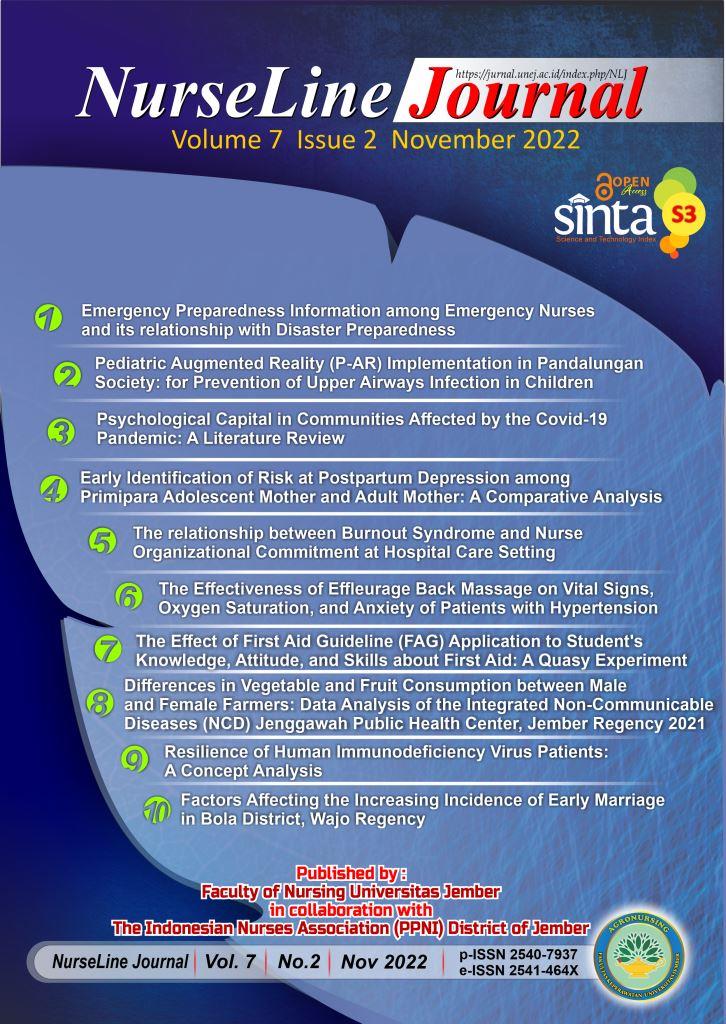Pediatric Augmented Reality (P-Ar) Implementation In Pandalungan Society: Prevention Of Upper Airways Infection On Children
DOI:
https://doi.org/10.19184/nlj.v7i2.30573Keywords:
children, acute respiratory infection, augmented realityAbstract
Acute respiratory infections (ARI) are still a major health problem in Indonesia and even in the world. It causes of mortality and morbidity of many people in developing countries. AR has the potential to provide contextual education in media and can help explore interconnections in information in cyberspace, people, especially children and parents can use AR to build new understandings based on their interactions with virtual objects. The research method used in this research is pre-experimental design. The type of research design that is expected to prove the effect of P-AR on ARI with the design of educational media. The method involves a group of mothers who have children with ARI taken by consecutive sampling in the community when the posyandu is run. The total participants in this study were 107 participants, with an age range of 21 - 40 years. there was a decrease in maternal stress levels as much as stress (SD± 19.25 - 9.644) and improvement in maternal resilience after the application of PAR with (SD± 5.35 - 8.38). Based on the results of research, shown that mothers who have children with respiratory infections to receive health care in hospitals can make mothers experience depression and anxiety. In addition, children also feel anxious about the presence of disease. So we need a coping strategy and information that can help in problem solving. AR can be used to improve emotional health in children.
Downloads
References
Das, P., Zhu, M., Mclaughlin, L., Bilgrami, Z., & Milanaik, R. L. (2017). Augmented Reality Video Games : New Possibilities and Implications for Children and Adolescents. Multimodal Technologis and Interact, 1(8), 1–10. https://doi.org/10.3390/mti1020008
Dinas Kesehatan Jember. (2019). Profil Kesehatan Kabupaten Jember 2018. 327. Retrieved from https://www.kemkes.go.id/resources/download/profil/PROFIL_KAB_KOTA_2018/3509_Jatim_Kab_Jember_2018.pdf
Haryani, P., & Triyono, J. (2017). Augmented Reality (Ar) Sebagai Teknologi Interaktif Dalam Pengenalan Benda Cagar Budaya Kepada Masyarakat. Simetris : Jurnal Teknik Mesin, Elektro Dan Ilmu Komputer, 8(2), 807. https://doi.org/10.24176/simet.v8i2.1614
Herdiana, I., Suryanto, D., & Handoyo, S. (2018). Family Resilience: A Conceptual Review, (January). https://doi.org/10.2991/acpch-17.2018.9
Hidayat, T. (2015). Penerapan Teknologi Augmented Reality Sebagai Model Media Edukasi Kesehatan Gigi Bagi Anak. Citec Journal, 2(1), 77–92.
Niki, I. (2019). Hubungan Pengetahuan Ibu dan Dukungan Keluarga Terhadap Upaya Pencegahan Infeksi Saluran Pernapasan Akut. Jurnal PROMKES, 7(2), 182. https://doi.org/10.20473/jpk.v7.i2.2019.182-192
Noviani, W. 2018. Hubungan Tingkat Stres Dengan Efikasi Diri Pada Pasien TB Paru Di Wilayah Kerja Puskesmas Patrang Kabupaten Jember. Universitas Jember.
Pedro, C. R., Freitas, P. P., Papoila, A. L., Dias, S. S., Caires, I., & Martins, P. (2017). Respiratory diseases in children attending kindergartens : Health-related variables and mothers’ psychological, parental, and marital functioning. Health Psychology, 1–8. https://doi.org/10.1177/2055102917724334
Putra, M. A. R. 2019. Hubungan Resiliensi dengan Burnout Pada Petani Padi di Desa Ampel Kecamatan Wuluhan. Skripsi. Fakultas Keperawatan Universitas Jember : Jember
Salawati, T., & Indrawati, N. D. (2015). Tahap Analisis untuk Pengembangan “ASETARO†Komik Pendidikan Kesehatan untuk Anak tentang Bahaya Merokok. Prosiding Universitas Muhammadiyah Semarang.
Syahidi, M. H., Gayatri, D., & Bantas, K. (2016). Faktor-faktor yang Mempengaruhi Kejadian Infeksi Saluran Pernapasan Akut (ISPA) pada Anak Berumur 12-59 Bulan di Puskesmas Kelurahan Tebet Barat, Kecamatan Tebet, Jakarta Selatan, Tahun 2013. Jurnal Epidemiologi Kesehatan Indonesia, 1(1), 23–27. https://doi.org/10.7454/epidkes.v1i1.1313
Shins, D. M., Basheer, D. M., & A, D. A. B. (2017). Social determinants of cardiovascular disease and community based surveillance. Public Health Review: International Journal of Public Health Research, 4(4), 71–74. https://doi.org/10.17511/ijphr.2017.i4.01
Tait, A.R., L. Conally., A. Doshi., A. Johnson., A. Skrzpek., M. Grimes., A. Becher., J. E. Choi dan M. Weber. 2020. Development and evaluation of an augmented reality education program for pediatric research. Journal of Clinical and Translational Research. 5(3):96-101.
Tanaem, G. H., Dary, M., & Istiarti, E. (2019). Family Centered Care Pada Perawatan Anak Di Rsud Soe Timor Tengah Selatan. Jurnal Riset Kesehatan, 8(1), 21. https://doi.org/10.31983/jrk.v8i1.3918
Yao, H., Alappattu, M., Robinson, M., & Lok, B. (2020). Applying Stress Management Techniques in Augmented Reality: Stress Induction and Reduction in Healthcare Providers During Virtual Triage Simulation. Proceedings - 2020 IEEE Conference on Virtual Reality and 3D User Interfaces, VRW 2020, 165–166. https://doi.org/10.1109/VRW50115.2020.00034.
Zahra, & Assetya, O. (2017). Kondisi Lingkungan Rumah dan Kejadian ISPA pada Balita di Indonesia. Jurnal Ekologi Kesehatan, 16(3), 121–129.
Zhu, E., Hadadgar, A., Masiello, I., & Zary, N. (2014). Augmented reality in healthcare education: An integrative review. PeerJ, 2014(1). https://doi.org/10.7717/peerj.469
Downloads
Published
Issue
Section
License
Copyright (c) 2022 NurseLine Journal

This work is licensed under a Creative Commons Attribution-ShareAlike 4.0 International License.








